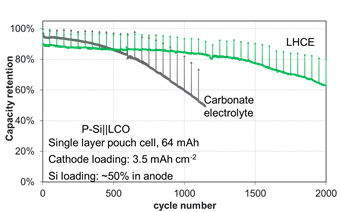Technology Overview
Silicon has long been appealing for use as a material in lithium-ion battery anodes, because its energy capacity is up to 10 times that of the commonly used material, graphite—leading to lithium-ion batteries with 20 to 40 percent higher energy density.
However, in batteries, lithium ions crowd into silicon anodes, which expand almost 300 percent in volume during charging, then shrink the same amount when the lithium ions exit during discharging, causing cracking, disintegration, and ultimately, a reduction in battery life. Many of the proposed silicon anodes that hope to tolerate the flow of lithium will require expensive starting materials and complex synthesis processes that use specialized equipment, making it challenging to produce at commercially relevant scales and costs.
To address these challenges, the Pacific Northwest National Laboratory (PNNL) has developed several complementary technologies that include a silicon-carbon composite that is formed into a high-performing anode, a ready-to-scale process for commercial production of the key porous silicon starting material, and an electrolyte that enhances performance of the silicon anodes.
The high-performance anode material
PNNL scientists have developed a silicon-carbon composite that exhibits high stability, high conductivity, and low particle-level expansion. The powder comprises micron-sized granules that are made of single nanometer-sized silicon primary particles covered and stabilized by carbon derived from inexpensive pitch. The carbon coats each single primary particle and forms an electrically conductive network among the collection of particles. This enables both high electrical conductivity and mechanical strength while guarding against penetration by the electrolyte, which causes unwanted side reactions. The sealed void space inside each composite particle allows for only 60 percent of initial swell of particles, significantly lower than the 300 percent expansion in bulk silicon. All of this contributes to superior performance evidenced by the thousands of cycles exhibited in PNNL’s full cells.
The scalable, low-cost process
PNNL’s silicon anode material is produced by a wet chemical process for coating the micron-sized porous silicon particles with carbon and uses readily available, low-cost, and abundant precursors. In contrast, many other silicon anode materials rely on conventional production methods that require complex chemistry and additional equipment—all of which add to the cost and difficulty of subsequent scale up for commercial production.
The micron-sized porous silicon particles are prepared by a similarly simple, scalable process that leads to high yield of porous silicon and well-controlled heat release during etching process. Furthermore, the etching agent is easily recovered and can be reused, minimizing waste generation and manufacturing costs.
The electrolyte
PNNL’s localized, high-concentration electrolyte (LHCE) is a unique formulation that delivers the benefits of concentrated electrolytes while exhibiting low viscosity. The PNNL team has developed a tailored, patent-pending composition for silicon anodes. When used with other silicon anodes in a lithium-ion battery, the LHCE significantly reduces leakage current, thus extending the cycle life of the battery by 50 percent or more.
When pairing the silicon-optimized LHCE with PNNL’s silicon-carbon anode and a high-voltage cathode, the combination has resulted in an 80 percent capacity retention after 2,000 cycles.
Applicability / Other Development & Availability
PNNL’s silicon-anode material, LHCE electrolyte, and synthesis process will help industry deliver on the high-energy potential of silicon-based, lithium-ion batteries while maintaining stability and long life so that consumers can enjoy the next generation of electronic devices, electric vehicles, and stationary energy storage.
Advantages
-
Carbon-coated porous silicon composite anode retains 88 percent capacity after 950 cycles.
-
Synthesis process delivers fine structure control over porous silicon and minimizes heat release during high-volume production.
- Novel electrolyte enables a greater than 50 percent increase in the cycle life of silicon-based lithium-ion batteries.
- Low-cost, scalable, and drop-in technology, with much higher energy density but comparable cost to that of graphite.
- Combination of micron-sized porous silicon and novel electrolyte can lead to a Li-ion battery with 80 percent capacity retention in 2,000 cycles.
State of Development
The trio of innovations is available for licensing individually, or as a suite of technologies, in all fields of use. You can view all of PNNL’s market-changing intellectual property at pnnl.gov/available-technologies.

